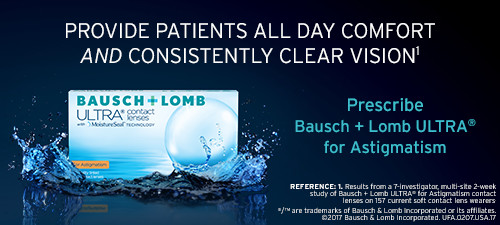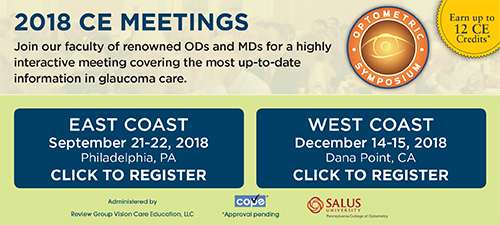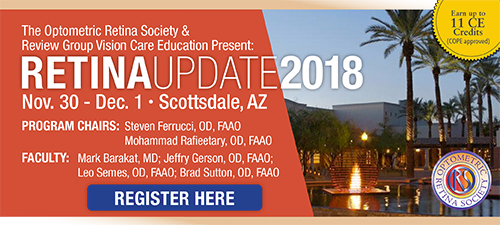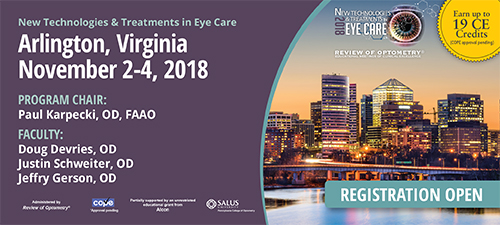
A
weekly e-journal by Art Epstein, OD, FAAO
Off the Cuff: Students, Debt and the Future of Optometry
Student debt is a steadily escalating problem for health care professionals. It has gotten so bad that this past week, the NYU School of Medicine announced that it is waving tuition for all new and existing medical school students. Their action is in response to growing debt among young doctors and the trend away from lower-paying, but much-needed, primary care practice. The school reportedly views this as a public health issue. The hope is that other medical schools will follow suit.
|
|||||
|
||||
| Unexpected Cause for Eyelid Swelling and Ptosis: Rigid Gas Permeable Contact Lens Migration Following a 28-year-old Trauma | ||||
A patient presented with left upper eyelid swelling and ptosis. The MRI reported a cyst with proteinaceous content. On surgical excision of the cyst, a rigid gas permeable (RGP) contact lens was found. The RGP lens was encapsulated within the upper eyelid soft tissue. It was later revealed that the patient had experienced childhood trauma while wearing RGP contact lenses 28 years previously. The patient had assumed that the RGP lens had fallen out and was lost; however, researchers inferred that the lens had migrated into the eyelid and resided there asymptomatically for 28 years. |
||||
SOURCE: Patel S, Tan LL, Murgatroyd H. Unexpected cause for eyelid swelling and ptosis: rigid gas permeable contact lens migration following a 28-year-old trauma. BMJ Case Rep. 2018;10;2018. |
||||
 |
||
| Corneal Sensitivity After Ocular Surgery | ||||
Authors wrote that the cornea is densely innervated with free nerve endings to provide a high level of sensitivity to foreign bodies or noxious substances, which also provide trophic support to the tissues of the cornea and facilitate their repair and replacement. Any reduction in the function of the nerve endings through disease, contact lens wear or surgery may lead to corneal disease, damage or reduced healing. Assessment of the corneal nerve function can be made by the use of specialized instruments (aesthesiometers) that stimulate the corneal nerves using different modalities—mechanical, chemical or thermal. Each modality assesses the function of a different cohort of corneal nerve type.
Ocular surgery, particularly corneal surgery, can produce significant damage to the corneal innervation. However, for the majority of surgical procedures, corneal sensation eventually returns to preoperative levels, given enough time. The principal exceptions to this are penetrating keratoplasty, epikeratophakia and cryo-keratomileusis, where sensation rarely returns to normal. Authors concluded that, for all types of surgery, the pattern of corneal sensation loss and recovery depends on the type, depth and extent of incision because these influence the number of nerve fibers severed and the healing response of the patient. |
||||
SOURCE: Lum E, Corbett MC, Murphy PJ. Corneal Sensitivity After Ocular Surgery. Eye Contact Lens. 2018; Aug 7. [Epub ahead of print]. |
||||
 |
||
| Early Macular Changes After Phacoemulsification in Eyes with High Myopia | ||||
This prospective cohort enrolled patients with high myopia (axial length ≥26mm) who underwent phacoemulsification with intraocular lens implantation. Spectral-domain optical coherence tomography (OCT) scans were obtained at baseline, and two and six months after the operation. Postoperative macular changes on OCT scans were regarded as the main outcome measure. Thirty-four eyes of 31 patients with high myopia were included (age, 60 years ±10 years [mean ±SD]); of these, 14 patients (45.2%) were male. The mean axial length was 27.8mm ±1.5mm. Epiretinal membrane (one eye, 2.9%), lamellar hole (one eye, 2.9%), myopic foveoschisis (two eyes, 5.9%) and vitreomacular traction associated with foveoschisis (one eye, 2.9%) were notable findings at baseline examination; no eyes showed cystoid macular edema (CME) at this time. At the two-month examination, three eyes (8.8%) developed CME. At the six-month follow-up, one eye with CME at two months improved, and a new case of CME (5.6%) was detected. The characteristics of epiretinal membrane, lamellar hole, vitreomacular traction and foveoschisis did not change at the two- and six-month examinations, and no new cases occurred. Investigators determined that uncomplicated phacoemulsification had no significant effect on the prevalence or characteristics of pre-existing macular abnormalities in eyes with high myopia at up to six months of follow-up. The incidence of CME two months after uncomplicated cataract surgery in eyes with high myopia was about 9%. |
||||
SOURCE: Ashraf H, Koohestani S, Nowroozzadeh MH. Early macular changes after phacoemulsification in eyes with high myopia. J Ophthalmic Vis Res. 2018;13(3):249-52. |
||||
 |
||
| News & Notes | |||||||||||||||||||||||||||||
Sun Pharma Receives FDA Approval for CEQUA to Treat DED |
|||||||||||||||||||||||||||||
Ivantis Gets FDA Nod for Hydrus Microstent Device for MIGS |
|||||||||||||||||||||||||||||
|
|||||||||||||||||||||||||||||
|
Optometric Physician™ (OP) newsletter is owned and published by Dr. Arthur Epstein. It is distributed by the Review Group, a Division of Jobson Medical Information LLC (JMI), 11 Campus Boulevard, Newtown Square, PA 19073. HOW TO ADVERTISE |






